This article originates from Richard's presentation at the virtual Customer Success Festival in 2023.
My name's Richard Convery, I'm the Head of Customer Success at Virtuoso. In this article, I’m going to be exploring a topic that I'm incredibly passionate about: optimizing onboarding to reduce early-stage churn.
I've worked in the SaaS world for about 13 years now, most of which have had some form of onboarding or implementation as part of my role. For me, it's a very exciting time when you can start to form really strong relationships with customers. When you can understand the value that the customer is trying to get from your platform and help them solve problems.
Here’s a breakdown of what I’ll be covering:
- The importance of onboarding,
- Benefits of great onboarding,
- The onboarding maturity curve,
- Optimizing processes,
- The sales handover, and
- The kickoff
Let’s get started!
The importance of onboarding
A big thanks to some friends of mine over at GuideCX, who have provided me with some stats. 👇

Did you know that $138 billion is actually lost in avoidable churn per year in the US alone? $138 billion.
Did you also know that 23% of all churn is attributed to bad onboarding? That's a worrying statistic, especially as onboarding is nearly always well within our control. (That's assuming that the customer is the right fit for us, so we must continuously iterate and improve to make sure that that is reduced.)
There was a study undertaken by the Harvard Business School that claims that, on average, a 5% increase in customer retention results in a 25% to 95% increase in profits.
On top of that, 65% of a company's business comes from existing customers. So there's a whole load of statistics around this, and it doesn't take away from the fact that actually what we need to do is focus on the customer and the value, and then those statistics will improve as a result.

I wanted to share with you a stat from Gainsight: 39% say the number one reason for churn is not meeting expectations. So let's make sure we know what the customer's expectations are, and that we help to set them from the word go.
But instead of focusing on these statistics around the negative side of things, we're going to focus on the positive, how we can make positive changes, reduce churn, increase the customer lifetime value, etc.
Benefits of great onboarding
On this slide, you can see I've got benefits categorized into two categories: the “End Customer”, and the “Provider.”
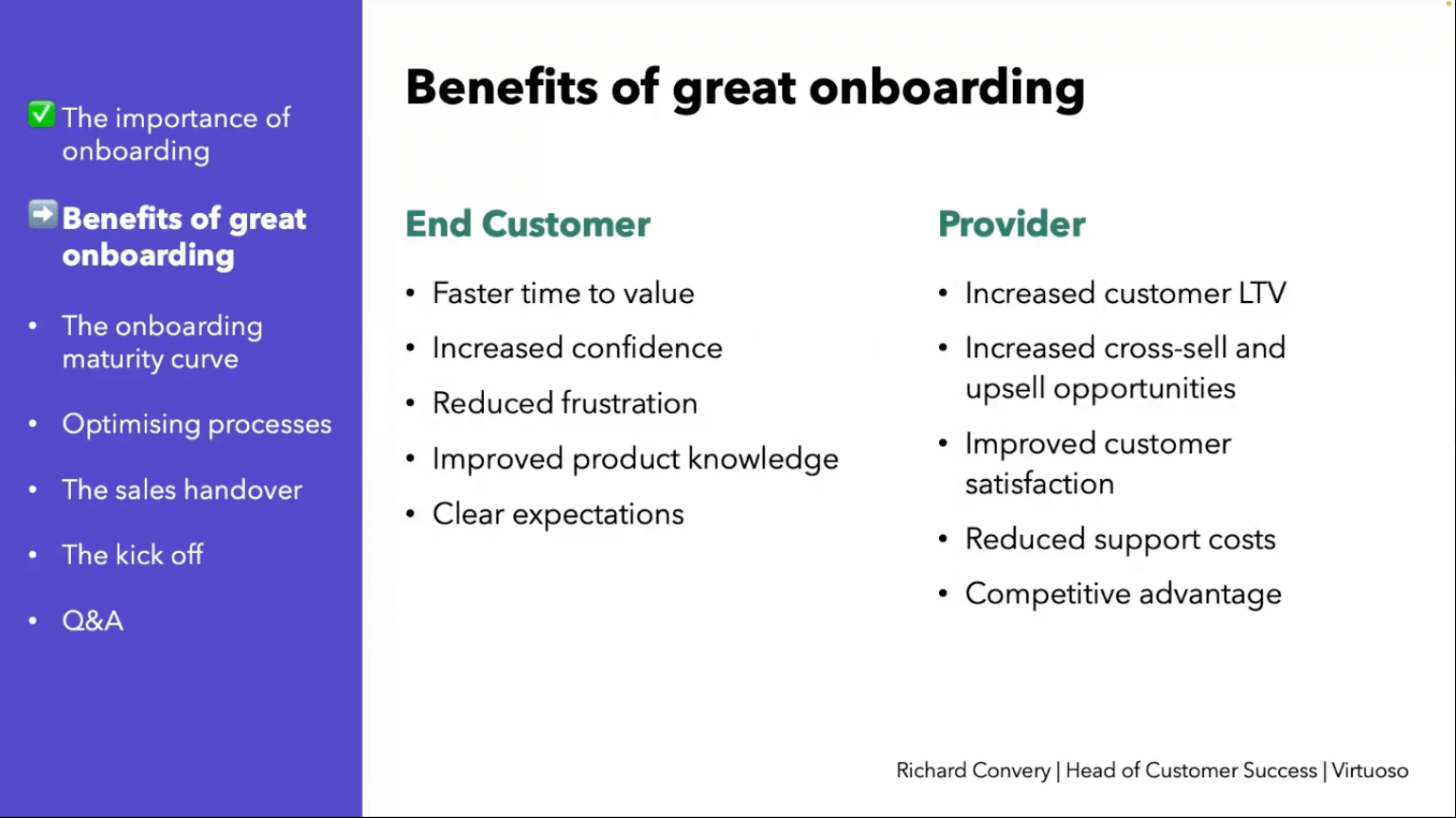
The "End Customer"
From the customer's perspective, great onboarding results in faster time to value because they're purchasing your tool or service for the value you provide. So the quicker you can get there, the happier the customer is.
They also gain increased confidence in you as a vendor. They might have may have picked you from a long list of vendors, and you want to make sure that you help them feel like they've made the right choice, especially if you’ve got something like a trial period where they can opt out. So after the first one-to-three months, you need to instill that confidence in them.
You're reducing the frustration of the end users.
A smooth and effective onboarding process, which includes training, will enable the customer to go faster, because there's nothing more frustrating than being enthusiastic about a product and wanting to use it, but you've come against blockers and you're not able to achieve what you want to achieve.
So each customer will have improved product knowledge. But that’s not just on the areas that they've purchased.
Think about this, you might have a number of different products within your suite and when the customer purchases one, this presents a fantastic opportunity for you to educate them on other areas of the business. Now those things might not necessarily be right for them right now, but actually educating them on those areas showcases your entire suite, and it plants the seed for upsell. It also gives them a vision of where they can be in the future.
Set clear expectations on both sides. The customer needs to understand what the process is, where they fit into it, and where they can get the most value. You gain a solid understanding of the customer's goals, and you can work to continuously deliver them to the customer.
The "Provider"
Let's have a look at the vendor, about the company's benefits to great onboarding. From a monetary perspective, you get an increased customer lifetime value.
Customers are gonna be happier, they're gonna stay with you longer, and they're gonna continue to spend. And that leads to cross-sell and upsell opportunities. If they see the value in what you’re doing from the outset, from the services and products you're providing, they're likely to invest more in your product, so they get more value in return. So this becomes an investment for them. It's not just a cost, it’s actually an investment.
You get improved customer satisfaction, and happy customers are more likely to tell others about your product.
Whether it be within the company or online community events, happy customers are your biggest marketing assets through case studies, online reviews, and referrals. And it's a hell of a lot cheaper to get referrals and upsells through existing customers than it is to spend money on bringing leads in from elsewhere.
An important one is reduced support costs. Anyone who has ever worked in a support or service desk before will understand the frustration of customers not being onboarded properly and asking very basic questions that they should have been educated on during the onboarding phase.
So you have fewer questions being asked, and the questions that do come over are probably more genuine. Perhaps they found a bug in the system, or want to know how to do more complicated things and that's okay. But if we can improve the training that's delivered, the low-level support requests are going to reduce as well.
Lastly, onboarding can be a real competitive advantage for you. So do something that your competitors don't by taking care of your customers.
It's okay to bring the onboarding team to the late-stage prospect calls to give them the confidence they're going to be looked after. Show them what it's like to be a customer, talk them through the onboarding process, and have a nice little presentation that you can talk through to say, “This is what things are going to look like over the next coming weeks and months.”
It's also less stressful for your team if you've got a good onboarding process. Onboarding should be enjoyable because, when done correctly, it's a genuinely positive stage in the customer process. They're coming into your company with a lot of momentum, which makes it the perfect chance to meet new people, build new relationships, and make people happy because you're solving their problems.
The onboarding maturity curve
In the image below, we've got a scale of behaviors ranging from “ad-hoc” and “defined”, to “managed,” through to “optimized” and finally, the place every CSM wants to be at, “proactive.”
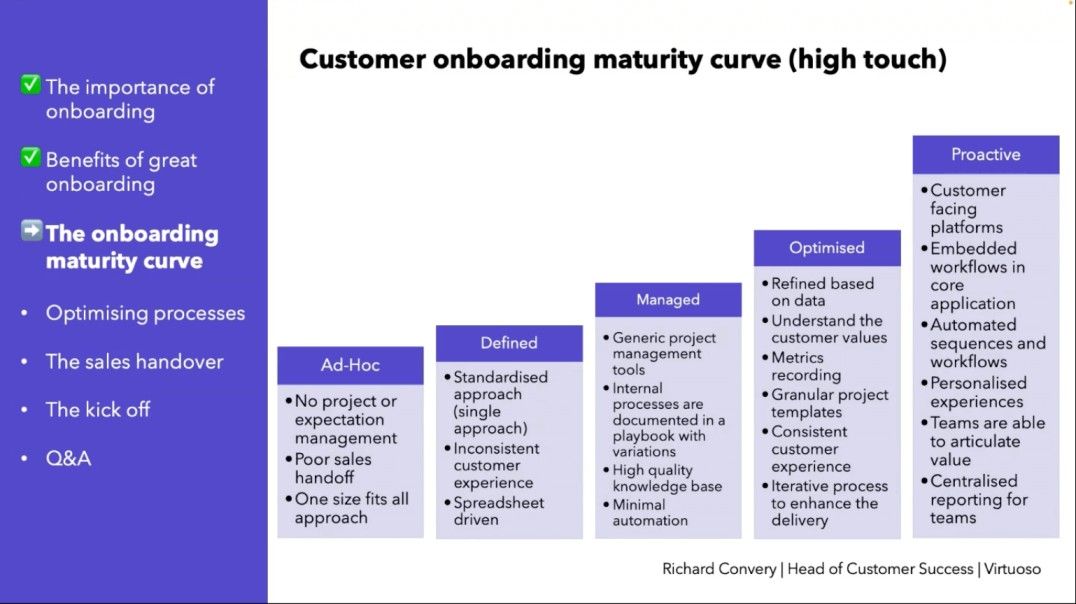
You’ve got the “ad hoc” on the left, which means you're very reactive to things, you don't have any project management, and you don't have any experience or expectation management.
The customer's onboarding from sales might be poor or even non-existent, you just kind of pick things up and see how it goes. And everybody tends to get the same onboarding experience, regardless of the size of the customer, the tier, the industry, etc., all those good segmentation pieces that can come in.
On the right, we're talking about the really proactive stuff. You've got customer-facing platforms where the customer can log in and see in real-time what's going on with the implementation.
Most of this has to do with high-touch onboarding. This would be very different from a low-touch perspective. But the customer can go in and have a look at what's going on, get real-time updates, and communicate with you across those platforms. You can even embed workflows into your core application.
Automation in onboarding
For example, you might have overlay software where the customer wants to find out how to create a quote (depending on what your product does) and then the application tells them to "click here", "now click here", "type this in here", "click here", and hey presto! It's as simple as that.
In some of these instances, you want to try to automate as much as possible without taking away the personal touch. It's okay to have automation in the right places. You've got automated sequences and workflows. So you might have emails and information being presented to the customer at the right time, be that asking for information, or it might be educating them.
Perhaps they've gone to a new part of the system they've never been to before, or they haven't visited for several months. What you can do is have an automated workflow that says, “Here's some information about X, Y, and Z," it points to a video that explains what they're trying to look at.
Articulate value
I think is important for the teams to be able to articulate the value as well. This is something that your sales team is very good at – articulating the value and benefits of the product. In CS, I think there's a lot of focus on features and functionality.
But you need to be asking why the customer bought that application from you in the first place. It's because they're trying to solve a problem – that’s the value, right? The value behind that problem. So make sure that your teams can articulate the value.
Centralized reporting
Finally, you've got centralized reporting. You've got so many different systems. You might have one system for reporting on system usage, you might have another system for your CRM, and with all this information all over the place, you want to make sure that your customer success managers, your onboarding consultants, and your implementation consultants, can view all of that holistically.
But also, you want to be able to step back and have a look at the reporting and see what's working well, and perhaps what isn't working so well. It's okay to know that some things aren't particularly great in your process, as long as you understand it, and you make improvements.
That's the first bit of the maturity curve.
And I want to share something else. I came across this from Rocketlane.
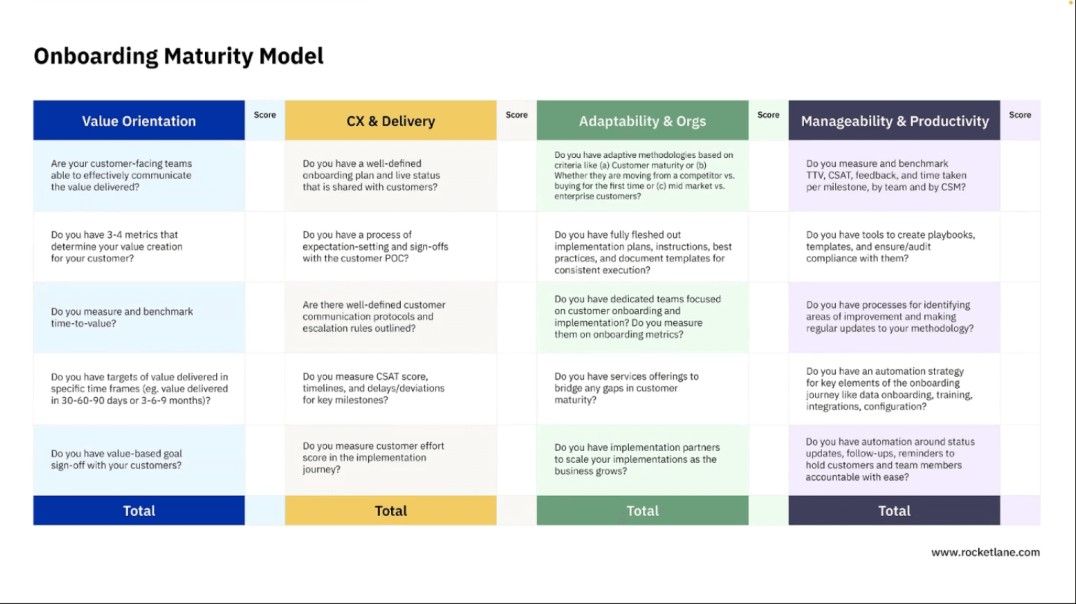
This is a lovely onboarding maturity model. It allows you to go in and assess each one of these categories. Give yourself an honest score of one to five, one-to-10, whatever it is, and assess how well you're doing in those particular areas.
Then from there, what I would do is break that down. If we were to take value orientation and the second one down, do you have three-to-four metrics to determine your value creation for your customers? Answer that honestly.
If you're at a three out of five, how can you make yourself a four? How can you make a five? It's not something that's just going to change overnight, it’s something that you're going to have to constantly improve upon. But you can do that for every single one of these areas. I think this is a really good tool that aids with self-reflection on the onboarding process.
Optimizing processes
When you're thinking about the onboarding process, start with the customer in mind, what is the value we’re trying to deliver? What's the best experience that the customer would want? Put yourself in their shoes. Forget about what is going to be easiest for you. If the customer is buying a service from you, make sure that you can deliver that value, and make sure that the customer is going to be happy, and then work back from there.
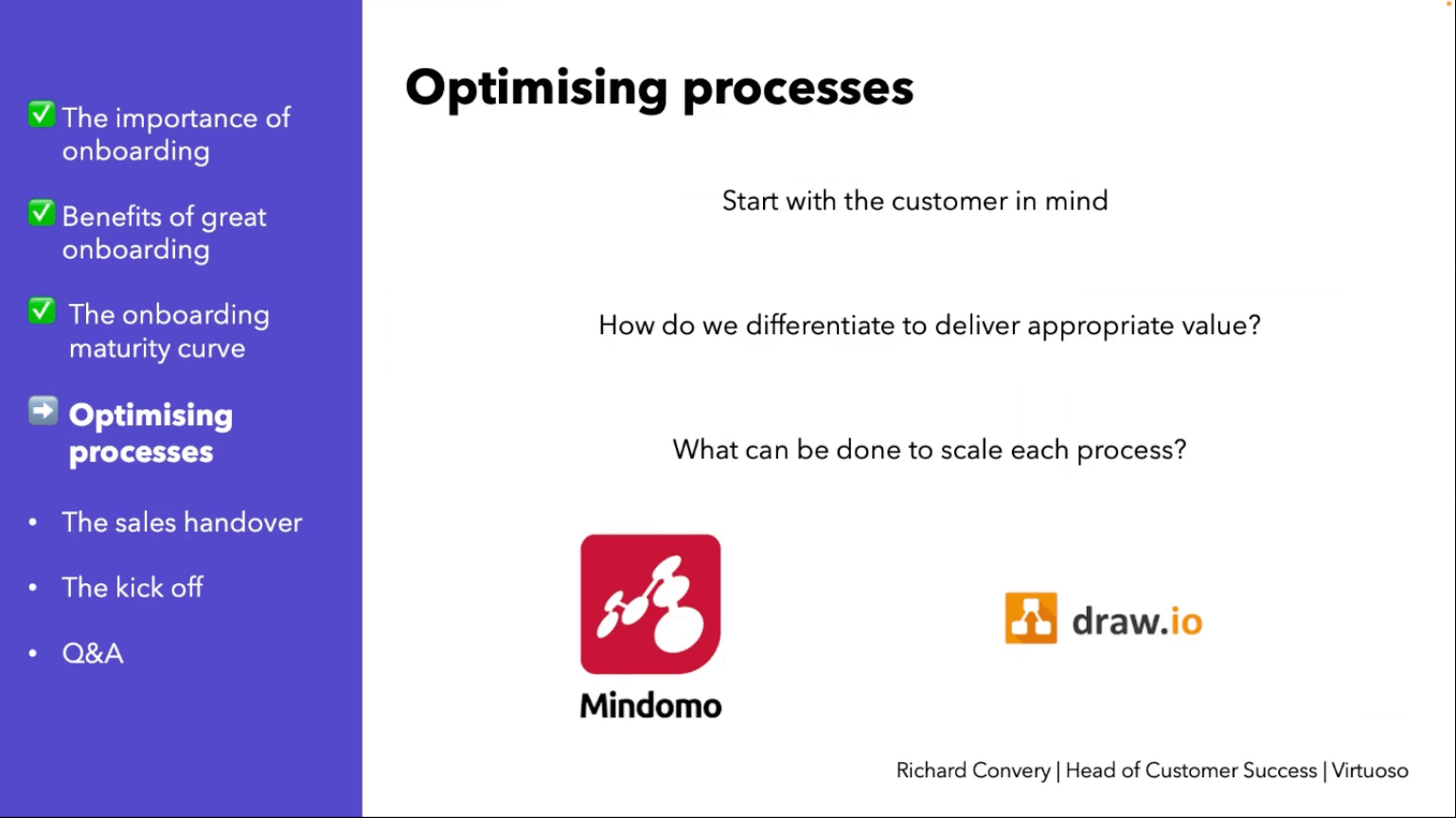
Once you've got the ideal process from a customer's perspective, you can then start to make your processes a little bit easier as well. Think about a swan crossing a lake, it looks really smooth and calm and collected on the surface. But underneath, its legs are going crazy. It's okay for your legs to go crazy, just make sure it’s going across gracefully. That's what the customer sees.
What I would also do is think about how you differentiate to deliver appropriate value. I would love to provide a top-class, sit-down-and-hold-your-hand-at-the-desk onboarding experience for every single customer. But that's just not possible.
We don't have all the time in the world. And we have to be fairly honest with ourselves, some customers pay more and we need to keep certain customers more than others. While that sounds bad, I think we need to be open and honest about it. So think about the different levels of value that you’re going to be providing for the different levels of onboarding and different types of customers.
Finally, if you were to get an increase of 100%, 200%, or 300% of your customers, are each one of your processes be scalable? Where's the bottleneck? What else can you do to use automation, or whatever it might be, to help you with scaling this process? I'll just share with you a couple of free really good tools that I use.
Mindomo is for mind maps, where you stick onboarding in the middle, create some branches off the side of it, and throw your ideas in there. And Draw.io, which is now Diagrams.net, is a flowchart maker. You can literally put blocks down for the process flow. So when we get a new customer, what happens?
We send them an email, who sends them an email, is it sales? Is it CS? Who updates the CRM? What happens in the CRM? Is there any automation? You can map out the entire process. And that kind of brings us on to the next part where we talk about the internal processes.
Internal processes
Once you've mapped out your process flow, get it into your playbook using Notion or whatever it might be. Get that in a central location so that new team members know exactly what your process is, and the existing team knows what the process is, and if things change, they've got a central place to go and update it and see what the changes are.
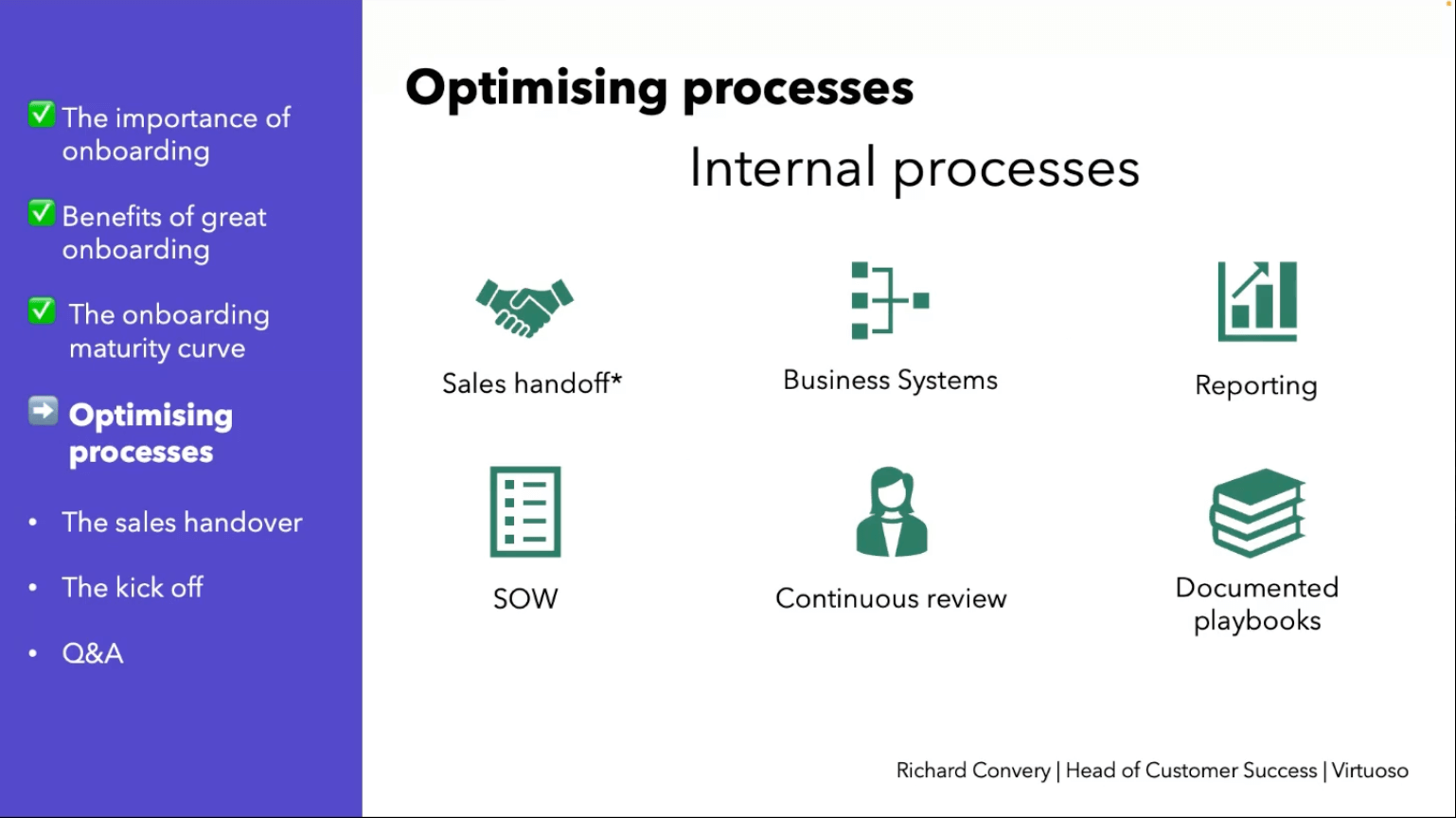
And when you're building out these processes, play devil's advocate – think about which of these processes could fail at a certain point.
Give this process to somebody else, and ask them to take a look. Can they see any examples where a certain customer would fall through the cracks? Because that's a terrible thing, you forget about a customer for a couple of weeks, especially during the onboarding process. Yeah, it's bad news.
In terms of business systems, I think all your business systems should be there to support the process. It’s there to work for you, not for you to spend all your time entering data. It's a really easy way in a number of business systems to start to automate some things, be it emails, contract creation, or notifications to your team of onboarding projects that are coming to an end or renewals that are coming up.
I always make sure that every time I have a call, I always just pop it in our CRM. I forget things, as everybody does, but you stick things in the CRM, you've got a full history as to what's going on, and you can remind yourself of the conversations that have been had.
It leads on to the reporting bits, the reporting bit is fantastic from a management's perspective. Reporting isn't the most exciting thing in the world. But honestly, managers, leaders, and members of the C-suite depend on that reporting. They need to know that things are going well, and that the onboarding process is going working as it should.
That's one side of things – making sure that the business is ticking along. But then there's also the reflective element, i.e. which areas of the onboarding process are taking longer than others.
Continuously review
So if you were to get, for example, a new member in the onboarding team, put them through the onboarding process, as if they were a customer. Get them to experience it like a customer would and get their feedback. You're bringing them on because they've got experience, so use that experience.
Talk to them about how onboarding worked at their last company. Ask what went well. What did they enjoy delivering? And perhaps ask what didn't go so well, and find out what changes they’d have made since.
External processes
When it comes to welcoming the customer, make sure you know who's sending out communications.
It doesn't matter if it's gonna be the salesperson who wants to continue a conversation, or if it's the implementation consultant who wants to step in and set up the first call, it doesn't really matter. But make sure that the email or whatever is going out is consistent for everybody. You include key information that you want to convey, and possibly even collect.
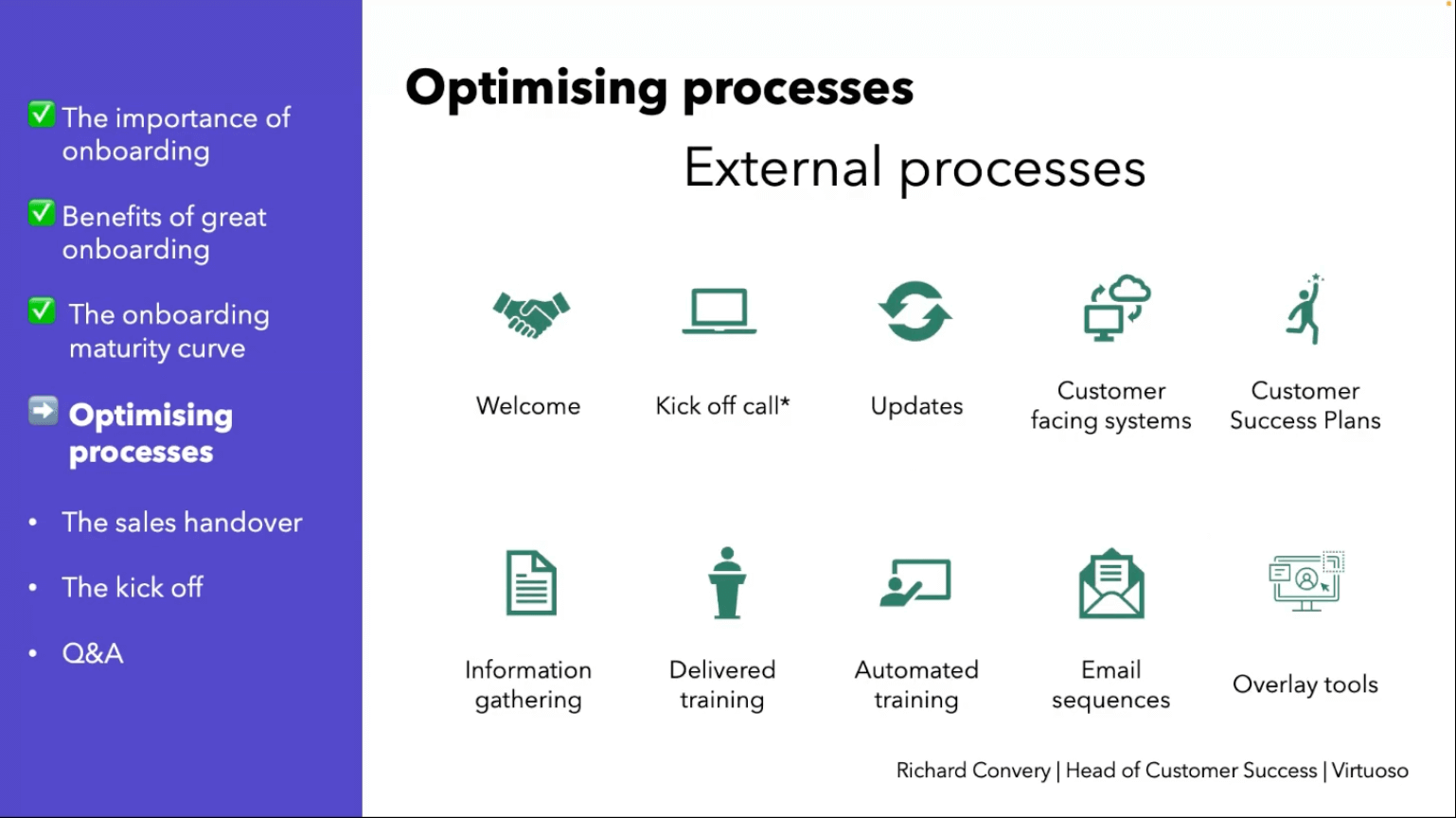
And it brings me down to the information-gathering section. You might want to use things like Google or Microsoft forms if you've got some standard key bits of information that you want to gather from your customers, it might be tax code, it might be charge-out rates, or whatever’s going to help you set up the customer system and get them going quicker. Think about standardizing some of that information gathering here.
For me, customer success plans are a really big one, and sometimes you might write this up in an onboarding plan as well. Make sure you understand the value, what are the values that the economic buyer at your customer sites is wanting to get. It’s really, really key.
In the past, I’ve spent time focusing on what the person in front of me is asking. And it's great, we're getting really good direction, and we’ve got a great relationship.
But lessons learned, you step back, the economic buyer, the person who's got the power to influence whether this is going to renew or whether it's going to continue, turned around and said, “Okay, well, I purchased this because I wanted that and you're doing some really good things over there. But you're not delivering on that”. That person there, that's somebody you really really need to listen to and make sure that you’re continuously having that in your mind and also pushing back on your customer.
Then everything from delivered training to overlay tools is all about education. You have to think about what the best combination of training tactics is. How to educate customers and improve adoption. And you need to consider that people learn in different ways. So make sure you diversify your material between written explanations, video walkthroughs, activities, ask-the-expert sessions, and all those kinds of things.
The sales-to-customer-success handover
When you're looking at the sales-to-customer-success handover, I'd consider a few things.
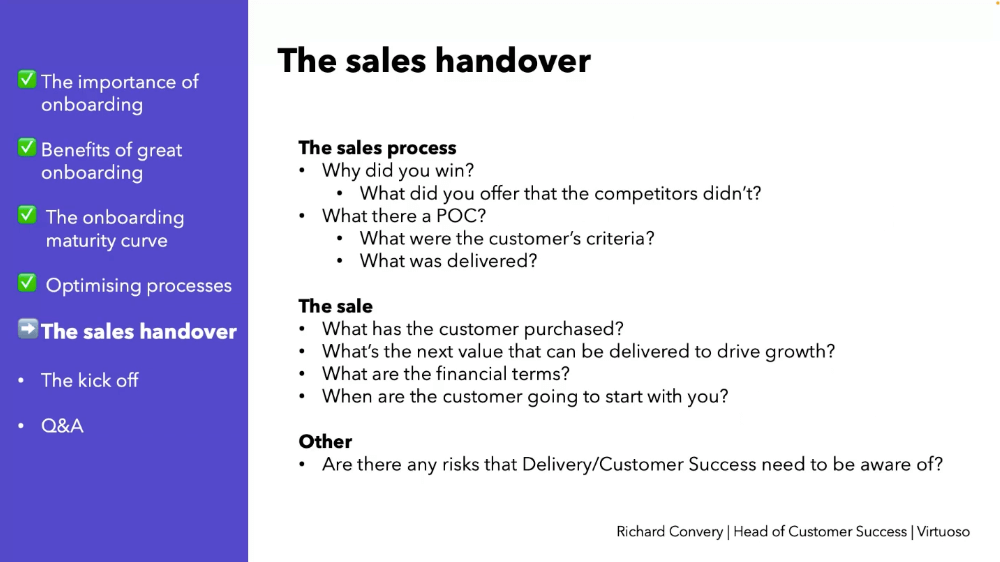
You've got to ask why did you win the customer over, what was the customer's criteria, and what was delivered. Then you've got to ask what has the customer purchased. What's the next value that can be delivered to drive growth, the financial terms and when is the customer going to start with you.
It very much depends on your organization and what the product is.
But straightaway, I want to know who the customer is:
- What do they do?
- What industry are they in?
- What do they sell?
- What makes them tick?
- What's the size of the company?
- Is there room for trying to gauge the size of the growth opportunities here as well?
- Who are the key contacts?
- Who's going to be the advocate?
- Who's responsible for the success of your product on the customer side?
- Who's the technical lead?
- What problems has the customer got?
- How big are those problems?
- Are there any compelling events?
And from the sales process perspective:
- Why did we win?
- Who are we up against?
- Why did they pick us over the competitors?
- Is there something that we do better than the others?
- Are there certain bits of functionality or features that give us added value?
- Was there a proof of concept?
- What was covered?
- What do we deliver?
- What was the customer looking for?
- What were they trying to prove?
And then some of the other transactional bits:
- What was purchased?
- What could they purchase next?
- What's the next value?
- What's the next thing?
- Where else do we take this?
- Are there any risks that we need to be aware of?
And I think it's worth mentioning that it's okay to show your personality, really being enthusiastic on the calls.
Being enthusiastic and showing your personality is not unprofessional. And I say it because a lot of the times in the past I've seen people be fairly robotic with things, and I don't know if that's because they're nervous. But it's okay to show your personality.
The kick-off
And then lastly, kick-off, these are the things that are kind of introductions and expectations. It's okay if a customer comes to the kickoff call without any expectations.
But ask them what their expectations are on the call and make sure you meet them. Things like an introduction to your company, and maybe even an assistant demonstration might be relevant if the people on the call have not been involved in the person-of-contact process.
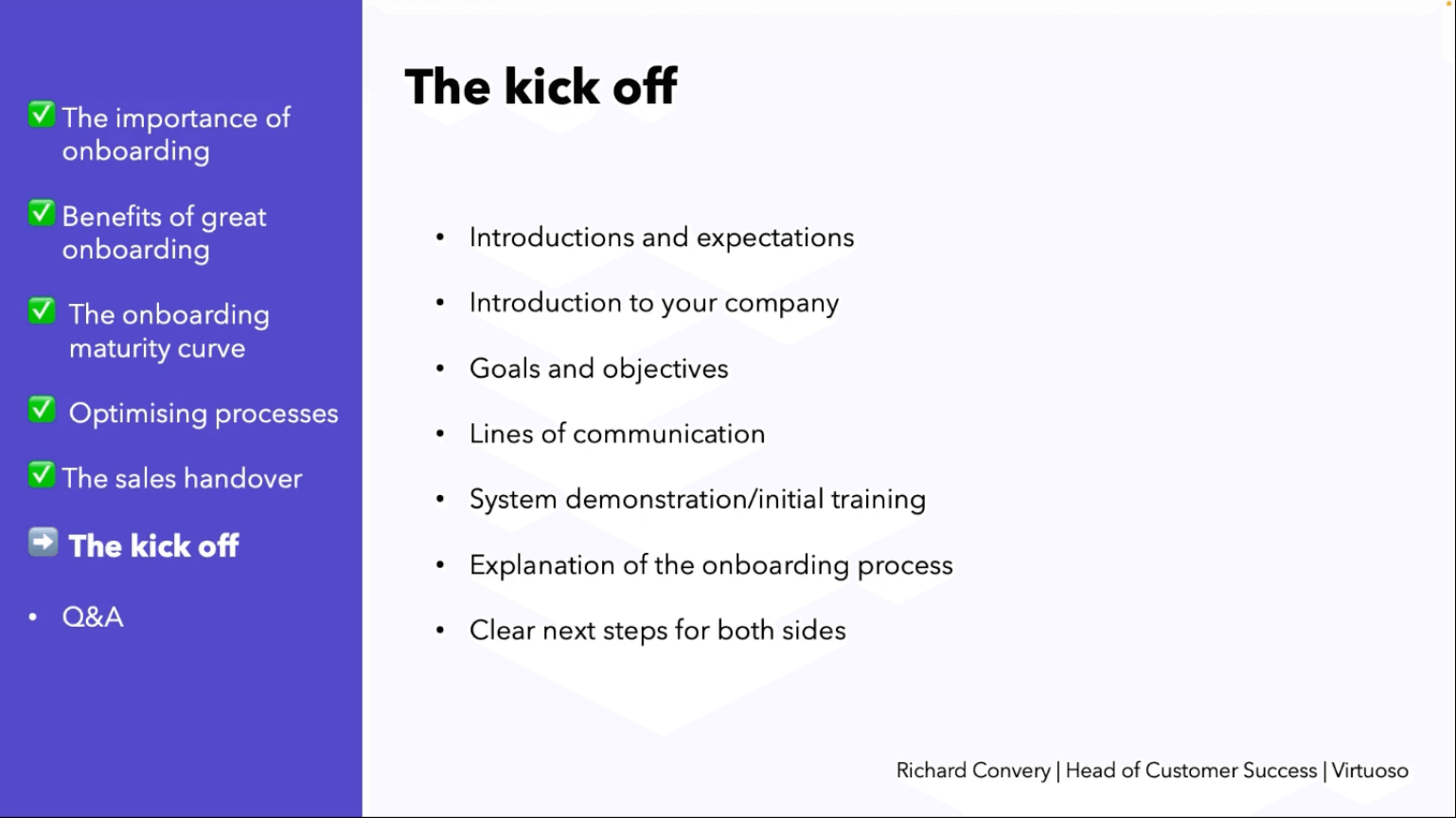
Otherwise, the two most important things for me are goals and objectives. What are their goals? And by when? Think about the lines of communication.
Do you want to create a Slack channel or a Teams channel to communicate with them? If they've got a question about finance, about support, about product, about whatever it might be, tell them who they need to talk to, and how they can contact them.
Final words of wisdom
Before I finish up, I wanted to share a brilliant question I’ve been asked a few times as I think this is a perfect way to end this article:
“Do you have any tips for managing onboarding where third parties are involved, like partners or service providers?”
Firstly, I would treat them as if they were just another consultant. They're just an extension of your team. Provide them with all the material they need, or the training. Just involve them as if they're part of your team. Sometimes you might want to enforce a process on them.
But you're bringing them on as a consultant or as a third party because they've got expertise in these areas. So it's okay to let them have a bit of creative freedom as long as you give them some guidelines and some boundaries.
Make sure that there’s an easy way for regular reporting and updates to come to the client and yourself, so you still maintain a level of control. At the end of the day, they're still your customer.
Thanks for reading this article!




